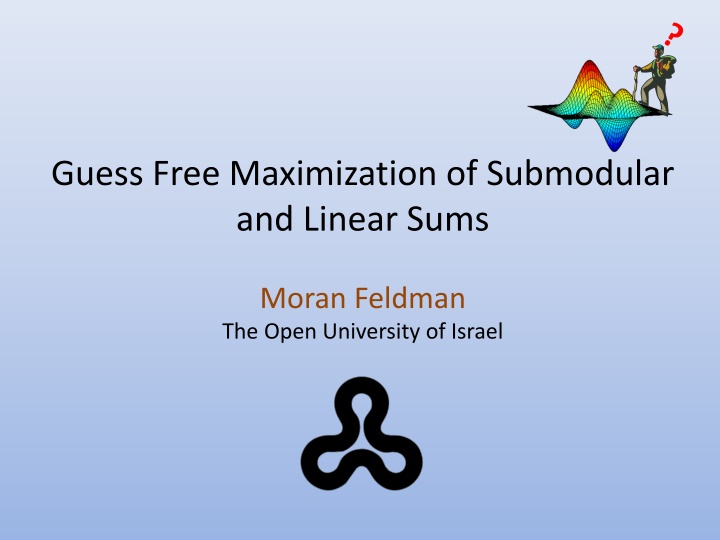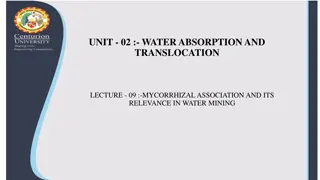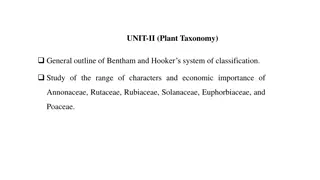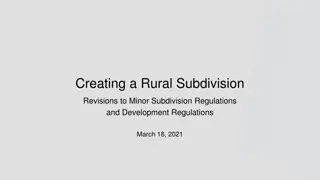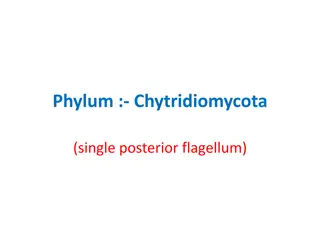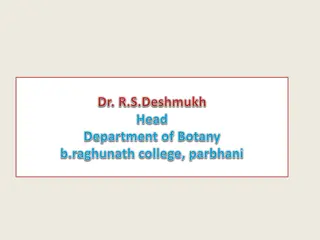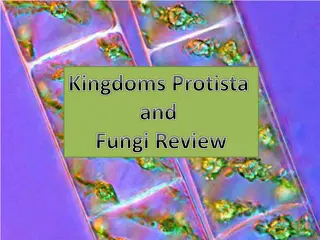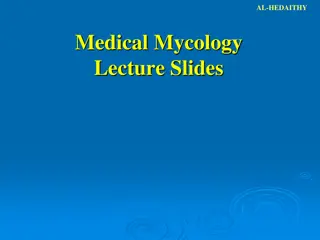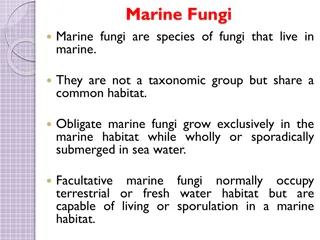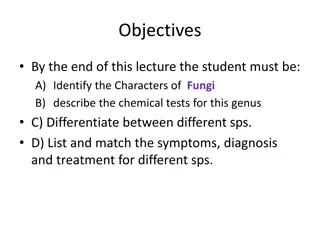Key Characteristics of Fungi Subdivisions and Families
Myxomycota and Eumycota are two main divisions of fungi, each with unique characteristics in terms of thallus structure, reproduction, and spore types. Within Eumycota, subdivisions like Mastigomycotina, Zygomycotina, Ascomycotina, Basidiomycotina, and Deuteromycotina exhibit distinct features. Additionally, the important traits of the Mastigomycotina class Oomycetes and Order Peronosporales are outlined, highlighting their role as pathogens and their specific reproductive and morphological characteristics.
Download Presentation

Please find below an Image/Link to download the presentation.
The content on the website is provided AS IS for your information and personal use only. It may not be sold, licensed, or shared on other websites without obtaining consent from the author.If you encounter any issues during the download, it is possible that the publisher has removed the file from their server.
You are allowed to download the files provided on this website for personal or commercial use, subject to the condition that they are used lawfully. All files are the property of their respective owners.
The content on the website is provided AS IS for your information and personal use only. It may not be sold, licensed, or shared on other websites without obtaining consent from the author.
E N D
Presentation Transcript
Guess Free Maximization of Submodular and Linear Sums Moran Feldman The Open University of Israel
Motivation: Adding Dessert Meal 1 Meal 2 Alternative Definition f(A) + f(B) f(A B) + f(A B) A, B N. Ground set N of elements (dishes). Valuation function f : 2N (a value for each meal). Submodularity: f(A + u) f(A) f(B + u) f(B) A B N, u B.
Another Example 7 11 0 6 8 10 5 4 -8 0 5 N 3
Submodular Optimization Submodular functions can be found in: Combinatorics Machine Learning Image Processing Algorithmic Game Theory Motivates the optimization of submodular functions subject to various constraints. Generalizes classical problems (such as Max DiCut and Max k-cover). Many practical applications. A B N. f(A) f(B) In this talk, we only consider maximization of non-negative monotone submodular functions. 4
The Multilinear Relaxation Sumodular maximization problems are discrete. Nevertheless, many state of the art algorithms for them make In the Linear World Solve a linear program relaxation. use of a continuous relaxation (in the same way LPs are often used in combinatorial algorithms). In the Submodular World Solve a relaxation. Solve a multilinear relaxation. max w x s.t. max s.t. s.t. The multilinear extension max F(x) x P x P x P It is a multilinear function Round the solution. Linear extension of the objective: Agrees with the objective on integral vectors. The Multilinear Extension Given a vector x [0, 1]N, F(x) is the expected value of f on a random set R(x) containing each element u N with probability xu, independently. Round the solution. 5
Continuous Greedy[Calinescu et al. 2011] The first algorithm for (approximately) solving the multilinear relaxation Can be (approx.) done because the step is infinitesimal. Description Start at the point 0. At every time between [0, 1], make a small step by adding an infinitesimal fraction of some vector x P. The vector x chosen is the vector yielding the maximum improvement. +x + x 6
Analyzing Continuous Greedy Feasibility We end up with a convex combination of points in the polytope. Lemma The multilinear relaxation is concave along positive directions. Use Regardless of our current location, there is a good direction: If y is the current solution, then adding an infinitesimal fraction of OPT (in P) is at least as good as adding an infinitesimal fraction of OPT (1 y), which increases the value by at least an infinitesimal fraction of F(y + OPT (1 y)) F(y) f(OPT) F(y) . 7
Approximation Ratio Differential Equation ??(?) ?? ? ??? ? ? . Solution F(y) (1 - e-t) f(OPT). For t = 1, the approximation ratio is 1 1/e 0.632. Known to be tight. Theorem When f is a non-negative monotone submodular function, the multilinear relaxation can be optimized up to a factor of 1 1/e. 8
Are we done? Theorem When f is a non-negative monotone submodular function, the multilinear relaxation can be optimized up to a factor of 1 1/e. Can we improve for special cases? In ML one often needs to optimize f(S) (S), where (S) is a linear regularizer. Often non-monotone. Hard to guarantee non- negativity. 9
Linear and Submodular Sums Theorem [Sviridenko, Vondr k and Ward (2017)] When f is the sum of a non-negative monotone submodular function g and a linear function , one can find in a polynomial time a vector x P such that F(x) (1 1/e) g(OPT) + (OPT) . Every non-negative monotone submodular f can be decomposed in this way. Improved approximation ratio when the linear component of OPT large. points. Have a guarantee also when the linear regularizer makes the function non- monotone or makes it negative at some 10
About the Alg. of Sviridenko et al. Doing so also increases by an infinitesimal fraction of (OPT) . We already saw adding an infinitesimal fraction of OPT increases g by an infinitesimal fraction of g(OPT) G(y) . By guessing (OPT) we can use an LP to find a direction with these guarantees. ? ? = ? ? + (y) (1-1/e) g(OPT) + (OPT) . ? (?) ?? ??(?) ?? Equation: At t = 1, (y) (OPT). Equation: At t = 1, G(y) (1 1/e) g(OPT). ??? ? ??? ? ? 11
Shortcomings of the Above Algorithm Expensive and Involved Guessing The algorithm has to be run for many guesses for (OPT). Slows the algorithm, and complicates its implementation. LP Solving In general, even the basic version of continuous greedy requires solving an LP. However, this can sometimes be avoided when the constraint polytope P has extra properties. The additional constraint in the algorithm of Sviridenko et al. prevents this saving. Matroid Speedup Tricks developed for speeding up continuous greedy for matroid constraints cannot be applied for the same reason. 12
Our Observation ? (?) ?? ??(?) ?? ??? ? ??? ? ? By explicit calculation of the imbalance, we get that we really want to maximize in time t the improvement in et 1 G(y) + (y) . Every extra gain now decreases the guarantee at later times. The gain now does not affect later guarantees. Gaining in is more important than gaining in G. This imbalance reduces with time. 13
Our Algorithm Start at the point 0. At every time between [0, 1], make a small step by adding an infinitesimal fraction of some vector x P. The vector x chosen is the vector yielding the maximum improvement in et 1 G(y) + (y) , where y is the current solution. No guesses No extra constraints Analysis We study the change in the potential function (t) = et 1 G(y(t)) + (y(t)) , where y(t) is the solution at time t. 14
Analysis (cont.) The derivative of (t) = et 1 G(y(t)) + (y(t)) , is at least et 1 G(y(t)) et 1 [g(OPT) - G(y(t))] + (OPT) Due to increase in et 1 The x chosen is at least as good as OPT Leads to (t) (et - 1 1/e) G(OPT) + ? (OPT). For t = 1, F(y(1)) = (1) (1 1/e) G(OPT) + (OPT) . 15
Follow Up Work A follow up work recently appeared in ICML 2019. [ Submodular Maximization beyond Non-negativity: Guarantees, Fast Algorithms, and Applications by Harshaw, Feldman, Ward and Karbasi] Results In this work we got the same approximation guarantee, but using faster algorithms, for cardinality constraint and the unconstrained problem. Extended the guarantee to weakly submodular functions. Technique Applied the same basic observation, but not to continuous greedy, but to a random greedy algorithm due to [Buchbinder et al. (2014)]. 16
